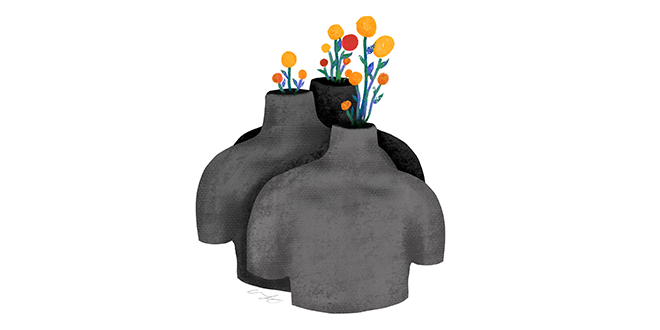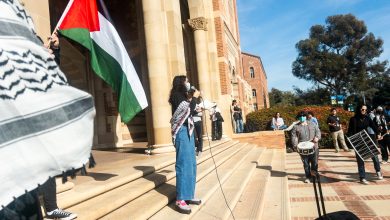What is a Body?

Design by Emily Farag
“If you are asked to describe an object, you answer that it is a body with a surface, impenetrable, shaped, colored, and movable. But subtract all these adjectives from your definition and what is left of that imaginary being you call a body?“— Denis Diderot, “Letters on the Deaf and Dumb.”
On Tuesday evening, Nov. 6, scholars from diverse disciplines joined the UCLA School of the Arts and Architecture to explore the question: “What is a body?” The event, as a part of the 10 questions series, offered to UCLA students and the general public to inspire conversations on ten interdisciplinary topics, was held on campus in Kaufman Hall.
The panel was led by professor Susan Foster, choreographer and scholar from the department of world arts & cultures, and dance; professor Jennifer Jay, environmental engineer from the department of civil and environmental engineering; Tracy Johnson, Maria Rowena Ross Chair of cell biology and biochemistry professor from the department of molecular, cell, and developmental biology; and professor Greg Lynn, architect from the department of architecture & urban Design, founder of Greg Lynn Form.
From the perspective of a microbiologist
The body is a physical vessel that creates a sense of life. It is composed by cells that construct tissues, a process which leads to the formation of organs and organ systems, which eventually form the structure of a body.
From the numerous molecular cells constructing our body, each cell has a fascinatingly unique function, yet the information that drives each cell are basically the same — genes. Cells within each individual share a common set of genes that defines the body plan. Meanwhile, we share genetic similarities with other human individuals and species. Genome-wide variation from one human being to another can be up to 0.5 percent (99.5 percent similarity), and 75 percent of mouse genes have equivalents in human genes.
There are two scientific breakthroughs changing how we think about genes and the body:
First is epigenetics, the study of heritable phenotype changes that do not involve alterations in DNA sequence. According to recent research, the offspring of mouses treated with different diets display vastly different phenotypes, showing that environmental features can fundamentally change the way genetic information is expressed. To understand our bodies, it is now crucial to understand how the body responds to the environment.
Second is the study of human microbiome. Research has shown that we consist of 70 to 90 percent microbe organisms, and only 10 to 30 percent of human cells (23,000 human to a million human microbiome genes). We must understand that microbes are not the enemy of the body. Instead, they are crucial for cells to function, and for different organs to communicate with each other. The study of human microbiome revolutionized our perception of the body, placing human microbiome at the center of our study.
While we understand the chemistry workings of a body, we should also think about how the value of different individuals’ bodies is being evaluated in the political environment.
Scientists understanding of cells will work to transform biology, together with our understandings of the body. However, the question of how much access researchers should have to the body remains unanswered. Who should have the dominance over the body? How will the question be answered when it comes to the body of women, particularly that of women of color?
Body in modern technology
Technology revolutionized the boundary of a body. When you think about the body in an environmental way, the body is not self-contained. Just as the orchid’s body is not complete without wasps as its genitalia(pollinators). In the same way, our visual perceptions are not completely self-contained to our eyes but extend to our visual aid technologies. With the help of technology, our eyes are everywhere. Points of view are multiplying through telescopes, microscopes, digital models, and special filming technology. Impossible views are now commonplace.
Serving to augment our powers, technology has grown closer to the body. Meanwhile, the body is increasingly distributive to technology. Performances of professional basketball players can be improved by special designed chairs able to accumulate data from the athlete, and keep their body warm during time out. What’s more, It is possible for us to have a body of robot following us while we walk to carry our baggage. Assistant robots can be built to know how we move and imitate our movement.
Using the modern technology, machines can be designed to have characteristics of the body, such as vision, reason, and assumptions. To customize our experience, they have learned to guess what we like before we like it. Our space is occupied by ghosts of security cameras and detectors, which monitor, analyze, improve, and disturb our experience of the body.
The technology crosses the intersection of physical and digital worlds, revolutionizing our bodily experiences. For example, programs such as Pokemon Go pull things from the virtual world and place it in the physical world. The game merges virtual experiences with the real, tangible world, and encourages people to get off their couches to have real life interactions.
It is now clear that the modern experiences of the body intertwines with technology. But how is technology challenging the boundary of the body? Can we say that the technology is posting threat to our body autonomy? With leaps and bounds the modern technology is advancing by, questions regarding its relationship with the body should be pondered.
Body as we feel it
The body is an instrument, a vehicle for taking oneself from here to there. It assists us to do projects and make explorations. The body is a medium through which we express and communicate.
However, no one has full control of the body, resulting in our expression often fails to align with our intentions. We often unwillingly experience both delights and pains throughout the body.
The body is pervasive, indispensable for performing daily activities. We can think with our body, for a body articulates the knowledge. Professor Susan Foster empowered her presentation through dancing combined with language, in which she explains bodily thinking as “a form of speaking, a form of writing, it generates traces, somehow decipherable.”
A body bends towards its name. Our body is reoriented with a name that can empower, inspire, or enable it. We are disciplined by social instructions to perform able-bodied or disable, attractive or unattractive, young or old, feminine or masculine. Through these performances, rights, resources, and responsibilities are assigned. A disabled body is put in a devalued position because it cannot perform the instruction of clapping or seeing. A masculine body is empowered in public spaces for the aggressive social assumption attached to it.
The body is a metaphor, which can have medical, or religious meanings under given contexts. A body is fluid. We attach names to describe it, names that defines the body momentarily. A body can be bending, standing, or jumping, able to conduct various expression, or carry various identities over time.
The body is various, it incorporates the possibility of what could be. In the moment, a body could be reading, speaking, or dancing. But is one activity more about the body than another? Are they equally skilled, expressive, or conscious?




